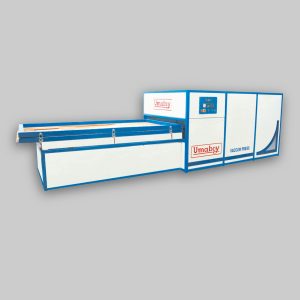Vacuum Press
What is a Vacuum Press Machine?
A vacuum press machine is used for bonding laminates, veneers, and PVC foils on wood-based panels. It uses vacuum pressure and heat to ensure strong and uniform adhesion across flat and curved surfaces.
Umaboy’s Vacuum Membrane Press Machine are specially engineered for high-quality lamination of PVC, foil, and veneer sheets over MDF, HDF, and wood panels. Designed for membrane door manufacturers, modular furniture producers, and panel processors, this machine ensures bubble-free bonding, deep embossing, and seamless surface finishing—every single time.
As a trusted brand since 1985, Umaboy leads India’s woodworking machinery industry with powerful, precision-engineered vacuum press technology.
Top Features of Umaboy Vacuum Press
- Heavy-duty silicon membrane for 3D pressing
- Digital temperature and pressure controls
- Energy-efficient heating system
- Compatible with curved and flat panels
- Fast cycle time for high productivity
How to Use a Vacuum Press Machine
- Place your MDF panel and PVC/veneer on the worktable.
- Cover with silicon membrane and ensure tight sealing.
- Set the temperature and vacuum time on the controller.
- Start the machine and wait for the bonding cycle.
- Once complete, release vacuum and remove the laminated panel.
Frequently Asked Questions – Vacuum Press Machine
1. What is a vacuum press used for in woodworking?
A vacuum press is used to bond laminates, veneers, PVC foils, and acrylic sheets onto MDF, plywood, and other substrates using heat and vacuum pressure. It ensures bubble-free, uniform adhesion even on complex surfaces.
2. Can a vacuum press handle 3D curved doors and panels?
Yes, Umaboy vacuum press machines are equipped with a silicon membrane that allows 3D forming, making them ideal for pressing curved MDF doors and panels with PVC foil or veneer.
3. What materials can be laminated using a vacuum press?
You can laminate PVC foil, natural veneer, acrylic sheets, high-gloss laminates, and decorative papers on MDF, plywood, and particleboard.
4. How long does it take to complete one pressing cycle?
Typical pressing time ranges from 4 to 8 minutes per cycle, depending on the material thickness, glue type, and heating method.
5. Is a vacuum press energy efficient?
Yes, Umaboy vacuum presses are designed with energy-efficient heaters and controlled vacuum cycles, optimizing power consumption without compromising performance.
6. What’s the difference between membrane and membrane-less vacuum presses?
Membrane presses use a silicon sheet for 3D shapes, while membrane-less models are faster for flat panels but can’t handle curved parts.
7. Do I need a skilled operator for running a vacuum press?
Basic operator training is recommended. However, Umaboy machines are user-friendly with automatic controls, making them suitable for most woodworking workshops.
8. Can vacuum presses be used in modular kitchen manufacturing?
Absolutely. Vacuum presses are widely used in modular kitchen and wardrobe manufacturing for applying decorative finishes and ensuring long-lasting adhesion.
9. What is the maintenance required for vacuum press machines?
Routine maintenance includes checking the vacuum pump, inspecting silicon membrane wear, cleaning the heating elements, and ensuring proper sealing for efficient vacuum performance.
10. What’s the average lifespan of a vacuum press?
With regular maintenance, Umaboy vacuum presses have a lifespan of over 8–10 years under regular industrial use.
Showing the single result
-
Vacuum Press
Vacuum Press – UVP 1010
Original price was: ₹700,000.00.₹500,000.00Current price is: ₹500,000.00. Add to cart


